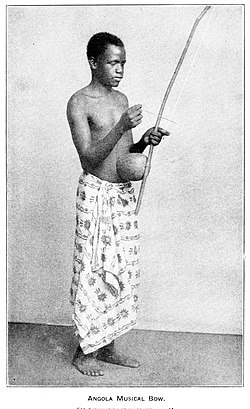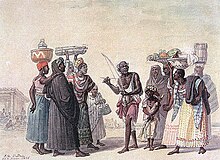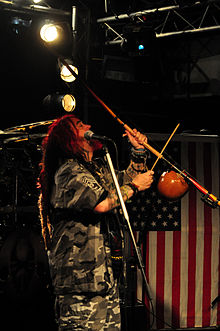| Revision as of 19:42, 28 August 2023 editMladifilozof (talk | contribs)Extended confirmed users7,402 edits →Berimbau in popular music← Previous edit | Revision as of 20:56, 28 August 2023 edit undoMladifilozof (talk | contribs)Extended confirmed users7,402 editsNo edit summaryNext edit → | ||
| Line 1: | Line 1: | ||
| {{Infobox instrument | {{Infobox instrument | ||
| |image= |
|image=History of Inventions USNM 41 Angola Muscial Bow.jpg | ||
| |image_size=250px | |||
| |caption=Viola, médio and gunga | |||
| |caption=Angola ] (]), known as berimbau in Brazil. | |||
| |name=Berimbau | |name=Berimbau | ||
| |names=urucungo, madimba lungungu | |names=urucungo, madimba lungungu | ||
| Line 13: | Line 14: | ||
| The berimbau was incorporated into the practice of the ] martial art ]. The berimbau leads the capoeiristas movement in the '']'' — the faster the berimbau is playing the faster the capoeirista moves in the game. | The berimbau was incorporated into the practice of the ] martial art ]. The berimbau leads the capoeiristas movement in the '']'' — the faster the berimbau is playing the faster the capoeirista moves in the game. | ||
| The instrument is also used in popular music. | |||
| The instrument is also known for being the subject matter of a popular song by Brazilian ]ist ], with lyrics by ]. | |||
| == History == | == History == | ||
Revision as of 20:56, 28 August 2023
 Angola musical bow (1922), known as berimbau in Brazil. Angola musical bow (1922), known as berimbau in Brazil. | |
| Other names | urucungo, madimba lungungu |
|---|---|
| Classification | percussion instrument and musical bow |
| Related instruments | |
| Belembaotuyan, Benta, Bobre, Diddley bow, Kalumbu, Malunga, Quijongo, Uhadi, Washtub bass | |
| Sound sample | |
 Problems playing this file? See media help. | |
The berimbau (Portuguese pronunciation: [beɾĩˈbaw]) is a single-string percussion instrument, a musical bow, originally from Africa, that is now commonly used in Brazil. The instrument is part of the candomblé tradition.
The berimbau was incorporated into the practice of the Afro-Brazilian martial art capoeira. The berimbau leads the capoeiristas movement in the roda — the faster the berimbau is playing the faster the capoeirista moves in the game.
The instrument is also used in popular music.
History

Berimbau is most likely an adaptation of African gourde musical bows, as no Indigenous Brazilian or European people use musical bows.
The way the berimbau and the m'bulumbumba of southwest Angola are made and played are very similar, as well as the tuning and basic patterns performed on these instruments. The assimilation of this African instrument into the Brazilian capoeira is evident also in other Bantu terms used for musical bows in Brazilian Portuguese, including urucungo, and madimba lungungu.
By the twentieth century, the instrument had come to be known as the berimbau, a Portuguese misnomer. The Portuguese used this word for their musical instrument the guimbarde, also known as a Jew's harp. As the Jew's harp and hungu shared some similarities when the latter was held in the mouth, the Portuguese referred to it as berimbau, akin to how the African lamellaphone came to be known in English as the "hand piano" or "thumb piano." The smaller type of the African bow (in which the performer's mouth is used as a resonator) was called the "berimbau de boca" (mouth guimbarde) whereas the gourd-resonating type became the "berimbau de barriga" (belly guimbarde).
The berimbau slowly came to replace the drum as the central instrument for the jogo de capoeira (capoeira game), which it is now famous for and widely associated with.
Design


The berimbau consists of a wooden bow (verga – traditionally made from biribá wood, which grows in Brazil), about 4 to 5 feet (1.2 to 1.5 metres) long, with a steel string (arame – often pulled from the inside of an automobile tire) tightly strung and secured from one end of the verga to the other. A gourd (cabaça), dried, opened and hollowed-out, attached to the lower portion of the verga by a loop of tough string, acts as a resonator.
Starting in the 1950s, Brazilian berimbaus were painted in bright colors, following local Brazilian taste; today, most makers follow the tourist consumer's quest for (faux) authenticity, and use clear varnish and discreet decoration.
To play the berimbau, one holds it in one hand, wrapping the two middle fingers around the verga, and placing the little finger under the cabaça's string loop (the anel), and balancing the weight there. A small stone or coin (pedra or dobrão) is held between the index and thumb of the same hand that holds the berimbau. The cabaça is rested against the abdomen. In the other hand, one holds a stick (baqueta or vaqueta – usually wooden, very rarely made of metal) and a shaker (caxixi). One strikes the arame with the baqueta to produce the sound. The caxixi accompanies the baqueta. The dobrão is moved back and forth from the arame to change the pitch produced by the berimbau. The sound can also be altered by moving the cabaça back and forth from the abdomen, producing a wah-like sound.
Parts and accessories of the berimbau:
- Verga: wooden bow that makes up the main body of the Berimbau
- Arame: steel string
- Cabaça: opened, dried and hollowed out gourd-like fruit secured to the lower portion of the berimbau, used to amplify and resonate the sound
Calling the cabaça a gourd is technically a mistake. As far as Brazilian berimbaus are concerned, the fruit used for the berimbau's resonator, while still known in Brazil as cabaça ("gourd"), it is not technically a gourd (family Cucurbitaceae); instead, it is the fruit of an unrelated species, the tree Crescentia cujete (family Bignoniaceae), known in Brazil as calabaça, cueira, cuia, or cabaceira.
- Pedra or Dobrão: small stone or coin pressed against the arame to change the tone of the berimbau
- Baqueta: small stick struck against the arame to produce the sound
- Caxixi: small rattle that optionally accompanies the baqueta in the same hand
Capoeiristas split berimbaus in three categories:
- Gunga (others say Berra-boi): lowest tone
- Médio (others say Viola): medium tone
- Viola (Violinha if the medium tone is Viola): highest tone
These categories relate to sound, not to size. The berimbau's quality does not depend on the length of the verga or the size of the gourd, rather on the diameter and hardness of the verga's wood and the quality of the cabaça.
Sound

The berimbau, as played for capoeira, basically has three sounds: the open string sound, the high sound, and the buzz sound.
- In playing the buzz sound, one holds easily the gourd closed against one's belly, while touching the string with the dobrão. A muted "tch" sound emerges.
- To play the open string sound, one strikes the string less than an inch up from the gourd string, with the bow balanced on the little finger so that the gourd is opened. One can grossly tune the open sound, by loosening the arame, and by sliding the gourd a little up or down from the place where the sound is best.
- To produce the high sound, one must hold the bow in the same way, gourd opened, and forcefully press the dobrão on the string. The sound differs from the low sound in tone and in timbre. Old recordings and musicians report that the difference in tone used to be about 1 tone (the interval from C to D). One can press the dobrão away enough from the gourd for this only if the bow is about 4 feet (1.2 m) to 4 feet 2 inches (122 to 127 cm); that was the length of the bows in the 1940s and 1950s. Today, many berimbaus are overgrown to 5 feet (150 cm), and tuning options are limited in berimbau ensembles.
Other sounds may appear in a berimbau performance, but only these define capoeira's rhythmic patterns (except Iuna).
Closing and opening the gourd while the string resounds produces a wah-wah effects, which depends on how large the gourd opening is. Whether this effect is desirable or not is a matter of controversy. Pressing the dobrão after striking the string is a widely used technique; so is closing neatly the gourd while the string resounds to shut off the sound. A specific toque requires the open string sound with closed gourd. Musicians use whatever sound they may get out of the string. It is not often considered bad practice to strike other parts of the instrument. As with most aspects of playing the berimbau, the names of the techniques differ from teacher to teacher. Most teachers, and most students, worry more about producing a nice sound than about naming the individual sounds.
Of course, the strength (velocity, accent) with which one lets the baqueta hit the string is paramount to rhythm quality. The open sound is naturally stronger (meaning that, for a constant-strength strike, the other two sound weaker), but the musician may decide which strikes to stress. Also, the sound tone shifts a little with the strength of the strike, and some sophisticated toques make use of this.
Use in capoeira
Main article: Capoeira musicWhatever style the berimbaus call, the capoeirista must play, no matter if it is fast, slow, a fight, or only a playful game.
— Mestre Acordeon

In capoeira, the music required from the berimbau is essentially rhythmic. Most of the patterns, or toques, derive from a single basic structure. Capoeira musicians produce many variations upon the basic pattern. They give names to known variations, and when such a named variation occurs repeatedly while playing, they call what they are playing by the name of that variation. The most common names are "Angola" and "São Bento Grande". There is much talking about the meaning of these terms.
In capoeira Angola, three Berimbaus play together. Each berimbau holds a position in relation to the "roda":
- The gunga plays "Angola" and is most commonly played by a mestre or the highest grade capoeirista around. Depending on the style of the group and the personality of the individual, the gunga may improvise a lot or stick strictly to the main rhythm. The person playing the gunga at the beginning of a roda is often the leader of the roda and the other instruments follow as well. The gunga player may also lead the singing, which is made easier by the simple rhythm and little variation that he plays. The gunga is used to call players to the pé-do-berimbau (foot of the berimbau, where players enter the game).
- The médio plays "Sao Bento Pequeno". For instance, while the gunga may play a simple, eight-unit pattern like (xxL.H.H.), the viola (or médio) can play a sixteen-unit variation, like (xxL.xLHL|.xL.H.H.). The dialog between gunga and viola (or médio) gives the toque its character. In the context of capoeira Angola, the médio inverts the gunga's melody (Angola toque): (xxL.H...) by playing São Bento Pequeno: (xxH.L...) with moderate improvisation.
- The viola plays "Sao Bento Grande". Mostly variations and improvisations. It may be described as the "lead guitar" of the "bateria".
Tuning in capoeira is also loosely defined. The berimbau is a microtonal instrument and while one can be tuned to play a major or minor 2nd, the actual tone is approximately a neutral second lying between a whole and half tone.
The berimbaus may be tuned to the same pitch, differing only in timbre. More commonly, low note of the médio is tuned in unison to the high note of the Gunga, and likewise for the viola to the médio. Others like to tune the instruments in 4ths (C, F, B flat) or a triad (C, E, G). Any tuning is acceptable provided it sounds good to the master's ear.
There are countless different rhythms or toques played on the berimbau.
Toques
Main article: Capoeira toquesCommon toques names are:
- Angola: rests on (does not play) the last beat of the basic leaving (xxL.H...)
- São Bento Pequeno de Angola Invertido: similar to Angola but with the high and low tones reversed (xxH.L...). São Bento Pequeno is typically played on Médio in conjunction with Angola on the Gunga.
- São Bento Grande: adds an extra hit to São Bento Pequeno, (xxH.L.L.)
- São Bento Grande da Regional (or São Bento Grande de Bimba): an innovation of Mestre Bimba, is often played in the two bar pattern (xxL.xxH.|xxL.L.H.)
- Toque de Iúna: introduced to capoeira by Mestre Bimba. (L-L-L-L-L-xxL-L.) (the '-' = touching the dobrão to the arame without hitting).
- Cavalaria: in the past, used to warn Capoeiristas of the approach of police. (L.xxL.xxL.xxL.H.) is one example, variations exist.
In notating the toques, it is a convention to begin with the two buzzed tones, however it is worthwhile to note that they are pickups to the downbeat, and would more properly be transcribed: xx(L.H...xx)
São Bento Grande as played in a regional setting places the main stress or downbeat at the final L so that it sounds: (L.xxH.L.|L.xxH.L.L)
Other toques include Idalina: (L.L.x.H.|xxL.L.H.), Amazonas: (xxLLxxLH|xxLLLLLH), Banguela: (xxL.H.H.), all deriving from the basic capoeira pattern. The toque called "Santa Maria" is a four bar transcription of the corridos "Santa Maria" and "Apanha Laranja no Chão Tico Tico". (xxL.LLL.|xxL.LLH.|xxH.HHH.|xxH.LHL.)
Capoeiristas also play samba, before or after capoeira, with the proper toques, deriving from the samba de roda rhythmic pattern: (xxH.xxH.xx.H.HH.)
Berimbau in popular music

- Frank Colón, an American percussionist and composer, nick-named throughout Europe as "Berimbau Man".
- Electronic artist Bibio makes use of the berimbau on the track "K Is For Kelson", the first single from his 2011 album Mind Bokeh.
- Nana Vasconcelos played berimbau and other percussion instruments with modern jazz musicians worldwide.
- Max Cavalera, the lead singer and guitarist in metal bands Sepultura, Soulfly and Cavalera Conspiracy, has used this instrument many times in his music.
- Airto Moreira - Brazilian percussionist; works with many musicians and combines many styles from different continents
- Okay Temiz - Turkish jazz drummer and percussionist used berimbau in many songs, the most famous of which is "Denizalti Rüzgarlari" from 1975.
- Cut Chemist, turntablist of such groups as Ozomatli and Jurassic 5, made use of the berimbau in his single "The Garden".
- TaKeTiNa - The berimbau is used as a drone, along with the surdo, which serves as the "heartbeat", as part of the TaKeTiNa Rhythm Process, a musical, meditative group process for people who want to develop their awareness of rhythm.
- Minnesota metal band GRYZOR uses a modern contemporary version of the berimbau in their live show.
- Mauro Refosco, a Brazilian percussionist, plays the berimbau in the live rendition of the Atoms' "The Clock".
- Mickey Hart, percussionist for the Grateful Dead, played the berimbau on the song "Throwing Stones", as well as on several of his solo works.
- David Byrne's American Utopia Broadway musical and percussionists using berimbaus at during multiple songs during the show.
- MC Levin, a Brazilian funk artist has used berimbau to blend its successful hit Ela Me Falou Que Quer Rave.
Literature
- Assunção, Matthias Röhrig (2002). Capoeira: The History of an Afro-Brazilian Martial Art. Routledge. ISBN 978-0-7146-8086-6.
References
- ^ "Royal Museum for Central Africa, Belgium". Retrieved 2015-04-11.
- Funso S. Afọlayan (2004). Culture and Customs of South Africa. Greenwood Publishing Group. ISBN 978-0-313-32018-7. Retrieved 10 August 2012.
- Obi, T.J. Desch (2008). Fighting for Honor: The History of African Martial Art Traditions in the Atlantic World. Columbia, South Carolina, USA: University of South Carolina Press. p. 184. ISBN 9781570037184.
- O Estado de S. Paulo, 6–12 April 2011, Suplemento Agrícola, page 2
- Houaiss Dictionary
- Assunção 2002, pp. 200.
- "Frank Colón Percussion - Latin Lounge Band". Frankcolonpercussion.com. Retrieved 20 April 2021.
- King, Darryn (20 November 2019). "Building David Byrne's 'Utopia,' One Gray Suit at a Time". The New York Times. Retrieved 20 April 2021.
- Hear it here (noticeable from min 1:11 onwards)
See also
External links
- Berimbau Manual: notes, sounds and rhythms, types of berimbau
- Berimbau Free berimbau instructional videos taught by Mestre Virgulino.
- Berimbau how to set up a berimbau, how to play a berimbau, berimbau information
- The Berimbau Page at Rhythmweb
- Berimbau by Richard P. Graham and N. Scott Robinson